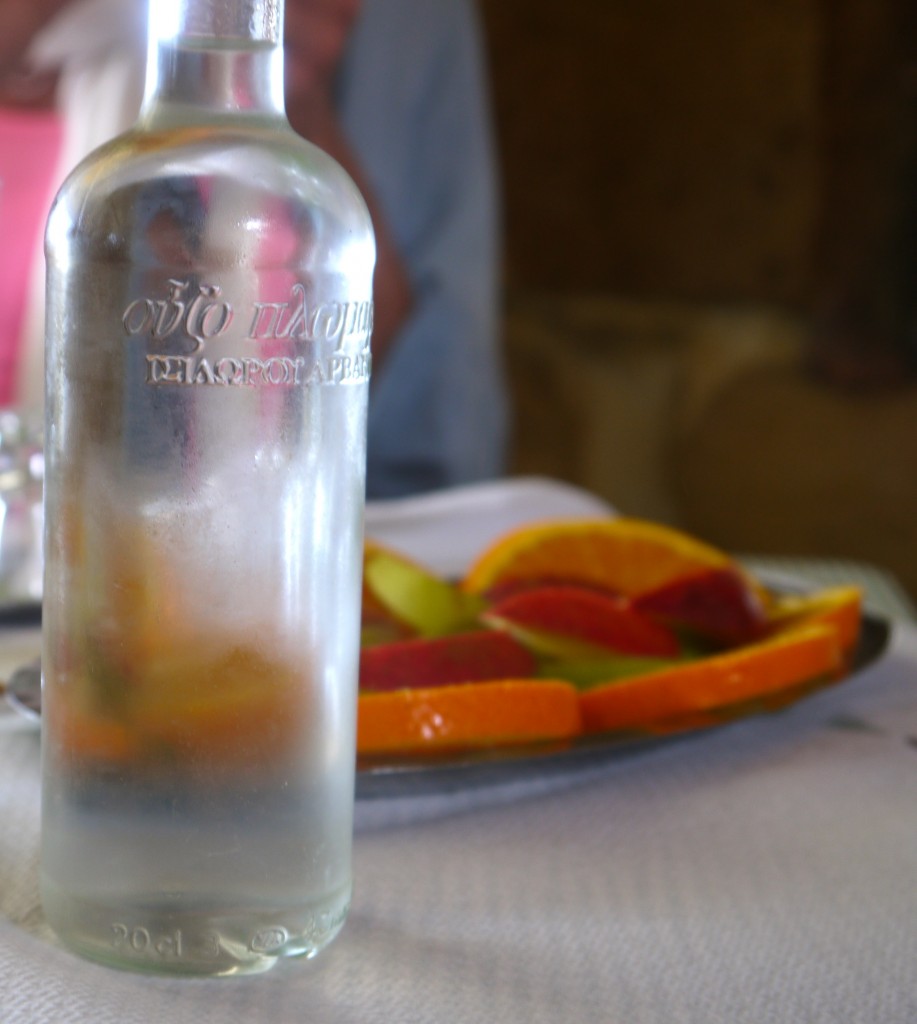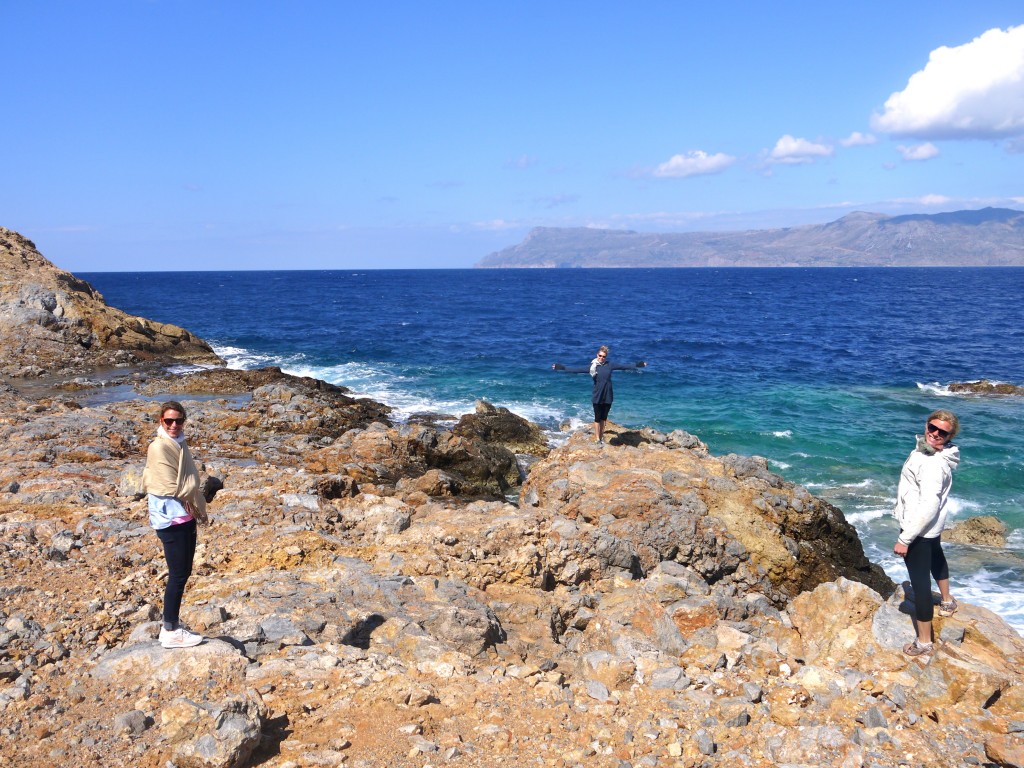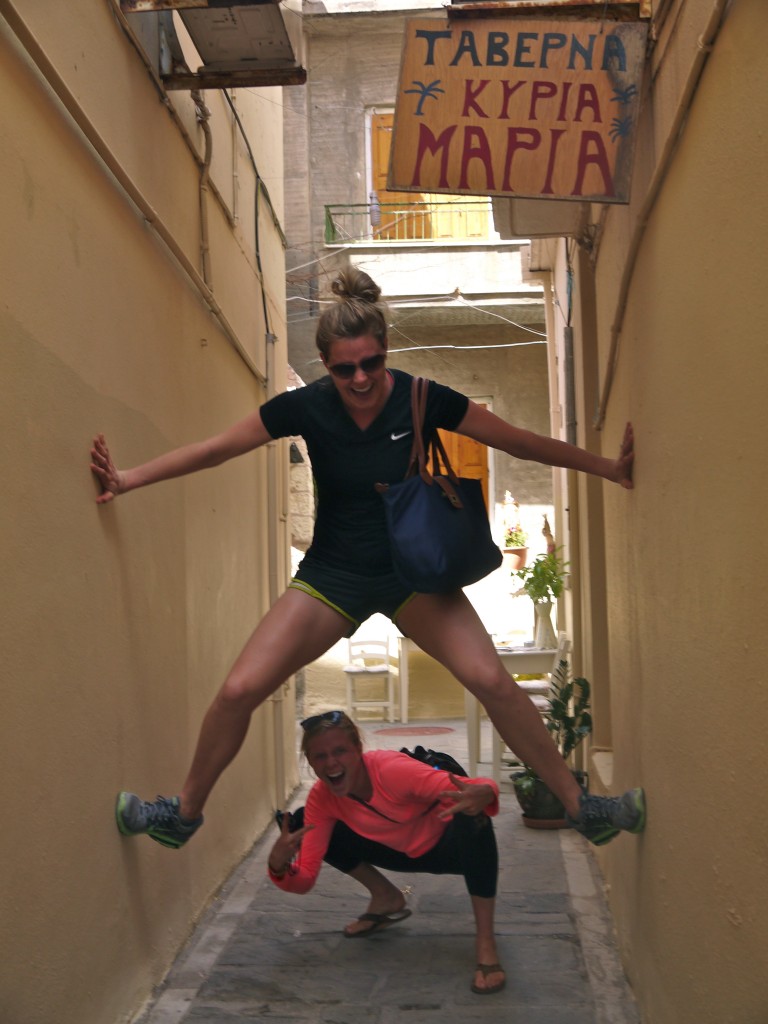Have you ever spontaneously planned a trip to Greece within 3 days, and also managed to convince your two sisters from W. Africa and San Francisco to join along??
Well, that just happened.
Why Greece?
Kyle and I have been living in Serbia, where he joined a professional basketball team mid-way through the season post-injury. With his season finished, the quick hop over from Belgrade was much too enticing.
Naturally, it was a great meeting place for sister bonding (plus Kyle), too.
Plus, why wouldn’t we want to indulge in the Mediterranean food and lifestyle? It is one of the most touted cultures for health in the WORLD.
Think about it – olive oil, Greek yogurt, and Greek salads are all famously derived from this land, and have made their way into everyday eating.
The Benefits of Mediterranean Eating
Thanks to Dr. Walter Willett of Harvard University’s School of Public Health, who presented this diet as a cultural model for healthy eating in the mid-1990’s, this way of eating has gained widespread recognition…
“This Mediterranean diet pyramid is based on food patterns typical of Crete, much of the rest of Greece, and southern Italy in the early 1960s, where adult life expectancy was among the highest in the world and rates of coronary heart disease, certain cancers, and other diet-related chronic diseases were among the lowest” (Willett, et. al, 1995).
Similar to the French Paradox, the people living in Mediterranean countries tend to consume relatively high amounts of fat, despite having much lower rates of cardiovascular disease than the U.S., where similar levels of fat consumption are found.
The superior health “side effects” of eating this way have been shown to, amongst TONS of other benefits:
- Reduce the risk of death (Martinez-Gonazalez, et. al., 2012)
- Have a protective effect towards acne (Skroza, et. al, 2012)
- Improve cognition/reducing cognitive decline from aging (Tangney, et. al., 2011)
- Improve metabolic syndrome, including preventing or reversing type 2 diabetes, improving weight loss and increased HDL-C (Richard, Couture, Desroches, Lichtenstein, Lamarche, 2012)
The Basics
So, what does this magical Mediterranean diet, er, way of eating involve to reap the health benefits? As I have both read and experienced, it includes:
1. High consumption of… OLIVE OIL!
As one of the oldest foods known to have originated in Crete or Syria 5,000 – 7,000 years ago (awesome!), olives and their oil are abundant (and the principal fat consumed) in all Mediterranean dishes.
Each and every restaurant had thick, liquid gold olive oil on their tables, and included it in most every dish. I’m so used to grilling waiters about the nasty (vegetable and canola) oils used that it was SUCH a breath of fresh air to not even have to question each restaurant’s oil integrity.
What’s so great about olive oil? As a highly anti-inflammatory oil, it is comprised of 75% oleic acid, a monounsaturated fat, which is linked to decreased blood pressure, improved cognition, decreased cholesterol, and cancer prevention (Mateljan, 2013). Win, win, win and win.
The best choice? Look for extra virgin olive oil first pressed/cold pressed, because it is unrefined and has the best flavor. Virgin olive oil has a higher acidity, and the misleading “pure olive oil” is the most refined and contains less nutrients. Also, buy it in a dark glass bottle to limit exposure to heat, light and oxygen!
2. High consumption of VEGETABLES and legumes!
My favorite meal of the day in Greece has been LUNCH, because of the abundant salad and vegetable options that are perfect for a mid-day energy and antioxidant boost!
I have most definitely eaten some form of a Greek salad every day, and I have a MUCH greater appreciation for eating it in the land where it was derived.
Think juicy tomatoes, red onions, crunchy cucumbers and peppers, olives, and whole fat, raw feta cheese drizzled in extra virgin olive oil….
The foundation of this salad was actually a crispy parmesan shell (EPIC!!).
A glimpse of our salads at lunch after touring the Acropolis in Athens…
Sprinkled throughout the streets of Crete, we also happened upon several local markets where we bought our own fresh produce.
3) High consumption of fruits (and maybe some raki…)
Without fail, almost every restaurant serves a plate of fresh, local, season fruits for dessert…
… along with homemade raki, a local distilled aperitif from grapes (pictured above and below). Bottoms up!
Hilary wasn’t a fan of raki… (too hilarious not to include.) I, on the other hand, moderately liked it, mainly because I felt it really did help with digestion!
Okay, so we may or may not have ALSO indulged in Greece’s famous baklava for dessert as well. It is ABSOLUTELY the most flaky, succulent, slightly nutty, slightly sweet dessert EVER. A rare indulgence for us, but so worth it!
4) Moderate consumption of dairy products (mostly as cheese and yogurt).
Though I normally abstain from most dairy due to sensitivity and these reasons, the unprocessed fresh cheeses and yogurt dishes were too delicious and more nutritious than conventional dairy not to indulge.
Besides the feta, we also loved on some thick, creamy tzaziki and its amazing flavors of yogurt, cream, cucumber, garlic, dill and olive oil…
Pictured below is moussaka, a famous traditional Greek dish with melted parmesan cheese on top and eggplant, potatoes, ground beef or lamb, onions, garlic and other amazing spices roasted in a clay pot.
Kyle indulged in this deeply flavorful gluten-free delicatessen at…
… our favorite farm-to-table local restaurant, Loggia, where we ate 4+ times!
We also took advantage of THE birthplace of Greek (frozen) yogurt!!! After a full day of walking in Athens, this seemed like a logical and refreshing choice… 🙂
Side note related to dairy: My dear little sister, who resides in W. Africa for the Peace Corps, couldn’t wait to get her hands on some pizza and Haagen-Daas after being away from “American” food for the last 1.5 years (can you sense the suspense?!).
She decided to eat both on one night (naturally), which about did her in (translation: she vomited that night. Oh, Hils…)! Perhaps, it’s a reminder that processed, sugary SAD (Standard American Diet) food is a far cry from the nourishing foods our bodies prefer?
5) Moderate consumption of fish.
Fresh fish caught the SAME day is such a rarity where I’m from, so I loved seeing the local fish market with the catches of the day!
As a huge fan of fish, this curried shrimp and rice brought me back to my South Carolina days…
I was also delighted to try a common local fish here, black seabream. Admittedly, I was not used to getting served the WHOLE fish, but didn’t mind the primal feel of eating it this way.
I also learned from a waiter that eating fish eyes (which is excellent for eye health!) is a good way to determine whether the fish is fresh or not.
As a first timer, I discovered I actually love them. (Is that weird?)
6) Low consumption of meat and meat products.
We definitely found ourselves eating less meat here, probably due to our greater consumption of vegetables and dairy products. However, we couldn’t help but get our meat fix in with the locally raised, famous LAMB here.
I forgot to mention our meat market experience in Athens, which involved walking through rows of full animal corpses (Glad I refrained from adding graphic pictures?).
Ironically, WE actually felt like the pieces of meat as we walked through (“Basketball?” “How’s the air up there?” Come on, people, really?).
7) High consumption of unrefined cereals, and moderate wine consumption.
As 99% gluten-free eaters, Kyle and I actually didn’t find many of the Greek dishes centered around grains, though I’m sure they are delicious.
My sisters indulged in the bread, though, which looked phenomenal. We did love on some local Cretan red wine most every night, too!
8) Regular physical activity!
As a staple of the Mediterranean Diet, exercise in Europe is much more prevalent and easier due to the walkability and presence of many markets. I often prefer living in Europe simply because we don’t need to drive nearly as much in our every day lives!
We certainly got our share of exercise in, starting with our tour of the Acropolis.
The architecture and rich history of this area was just as breathtaking as the views!
One of our favorite trips was a drive to Kissamos, about 1 hour, 15 minutes from where we stayed in Rethymnon, Crete. We were able to hike down to the brilliant blue waters along the coast!
Along the way, it was hilarious to drive through herds and herds of goats. They’re actually quite fascinating and surprisingly agile creatures.
Somehow, we all squeezed into this tiny Suzuki Splash. Kyle was a total trooper as our chauffeur, let alone dealing with three women in the car.
We also enjoyed touring the old part of town in Rethymnon…
Exquisite, isn’t it?
And we had our sister fun, which doesn’t come around much these days with our worldwide residencies…
Mediterranean Life Takeaways
Seriously, as I sit in a Cretan coffee shop documenting our adventures, I don’t think I’ve had a more pleasurable culinary adventure, full of local, seasonal, organic, Mediterranean GOODNESS in both Athens and the Island of Crete in Greece. Well, at least since our adventures at The French Laundry, of course.
All in all, I was absolutely won over with the quality, nourishing Mediterranean food (duh), delighted with the incredibly hospitable locals, and impressed with the exquisite architecture and oceanic views; all enriched by a much appreciated, rich history.
Though the weather wasn’t perfect, we enjoyed a relaxed, more quiet vacation full of exploring, cafes, intermittent beach time, culinary pleasures, inspiration, and loads of family bonding.
My heart is full. 🙂
:::
Your turn! Have you been to Greece? Which part(s), what were your favorite takeaways, and what was your favorite culinary dish?
:::
This post was shared on Party Wave Wednesday, Thank Your Body Thursday, Black Friday, Simple Lives Thursdays, Fat Tuesday.
References
Martinez-Gonzalez, Miguel, Guillen-Grima, Francisco, De Irala, Jokin, Ruiz-Canela, Miguel, Bes-Rastrollo Maira, Beunza, Juan, Lopez del Burgo, Cristina, Toledo, Estefania, Carlos, Silvia, and Sanchez-Villegas, Almudena. The Mediterranean Diet is Associated with a Reduction in Premature Mortality among Middle-Aged Adults. The Journal of Nutrition. 2012. <http://jn.nutrition.org/content/142/9/1672.abstract>.
Mateljan, George. Olive oil, extra virgin. The World’s Healthiest Foods. 2013. <http://whfoods.org/genpage.php?tname=foodspice&dbid=132>.
Richard, C., Couture, P., Desroches, S., Lichtenstein, A., Lamarche, B. Effect of weight loss, independent of change in diet composition, on apolipoprotein AI kinetic in men with metabolic syndrome. Journal of Lipid Research. 2012. <http://www.jlr.org/content/54/1/232.abstract>.
Skroza, N., Tolina, E., Semyono, L., Proiettei, I., Bernardini, N., Nicolucci, F., La Viola, G., Del Prete, G., Saulle, R., Potenza, C., La Torre, G. Mediterranean diet and familial dysmetabolism as factors influencing the development of acne. The Scandinavian Journal of Public Health. 2012. <http://sjp.sagepub.com/content/40/5/466.abstract>.
Tangney, C., Kwasny, M., Li, H., Wilson, R., Evans, D., Morris, Martha Clare. Adherence to a Mediterranean-type dietary pattern and cognitive decline in a community population. The American Journal of Clinical Nutrition. 22 December 2010. <http://www.ncbi.nlm.nih.gov/pmc/articles/PMC3041601/>.
Willett, W.C., Sacks, F., Trichopoulou, A., Drescher, G., Ferro-Luzzi, A., Helsing, E. and Trichopoulous, D. Mediterranean diet pyramid: a cultural model for healthy eating. The American Journal of Clinical Nutrition. 1995. <http://ajcn.nutrition.org/content/61/6/1402S.abstract>.
















![photo 1[1]](https://julesfuel.com/wp-content/uploads/2013/04/photo-11-e1366452932563.jpg)












![photo 1[2]](https://julesfuel.com/wp-content/uploads/2013/04/photo-12-e1366471112871-225x300.jpg)




